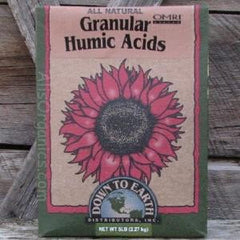Humus, Humate and Humic Acid, What They Do
Posted October 11, 2012


Humic Acid is becoming more and more recognized for its beneficial impact on the growth and cultivation of crops including vegetable and non-vegetables crops. Humic acid is not a fertilizer as it does not directly provide nutrients to plants, but is a compliment to fertilizers by making better use of them. When using Humic acids, plants are able to uptake and receive more nutrients. It will free up the nutrients in the soil so they are made available to the plant as needed. In areas where hard water is being used to irrigate, calcium, magnesium, and bicarbonate ions of hard water bind up phosphate and micronutrients so plants can't take them up while humates will help phosphorous and the micronurtients become available. Humic acid has the ability to chelate micronutrients increasing their bio-availability. Humic acids reduce toxicity from metals, pesticides, herbicides, and other agro-chemicals. Humic acids bind clay and sandy soil with organic matter together in the soil which increases soil structure and water-holding capacity and does not leach. Humic acids can be used as a foliar application to reduce transpiration and increase shoot size. Testing of some seeds have shown increased seed germination while using humic acid as a seed soak or by appling humic directly in the planting bed itself. Humic acid stimulates microbial activity which are responsible for the continued development of humus in the soil as it continues to break down matter that is not fully decomposed. A test of three years on a clay, nutrient lacking lawn, humic acid was used twice a year. The plug taken at the beginning showed very shallow roots (1-2") and no color in the soil. Disease was also present. After the three years a second plug was taken, showing that the roots had traveled to more then a foot in depth along with a dark brown color of the humate. The Humate traveled down into the clay, making it easier for the roots to grow deeper. Also, the plug tester was much easier to insert into the clay soil. With deeper root systems, less water is needed and less disease will occur. This lawn has been disease free, greener and overall healthier. To sum up what Humic Acids can do, increase root vitality, improve nutrient uptake, increase fertilizerretention, stimulate microbial activity, open clay soil up, reduce toxicity, and improve plants health and yields. It's like a bionic concentrated compost gone wild!



Comments (0 Comments)
There are no comments.
Post Comment